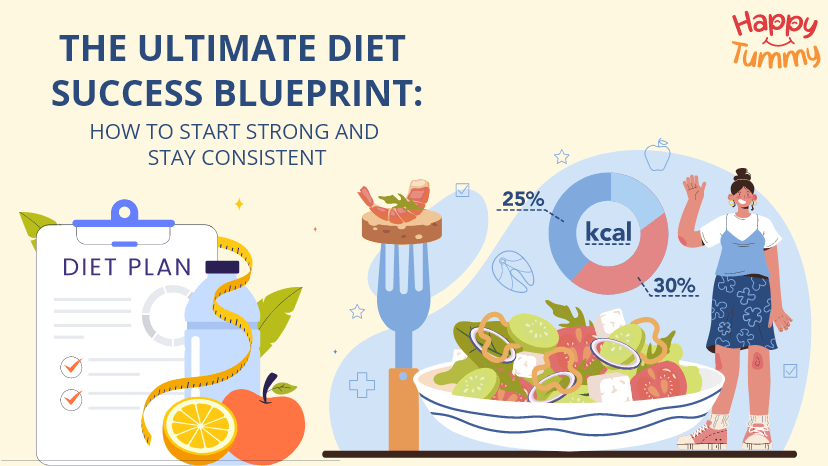Table of Contents
Starting a diet is easy — sticking to it is where most people stumble.
And we have all experienced the impetus of inspiration at the start of the first day, only to witness the deflation as urges, habits, or doubts creep in. The Ultimate Diet Success Blueprint is a write-up aimed at transforming that narrative.
It is not a quick-fix or magic-foods guide, but rather a guide on how to create the mindset, system, and habits that will make you consistent even when the initial excitement has died down.
You will learn how to get a good start, stay on track, and ultimately achieve long-term results, whether you are just getting started or find yourself getting distracted along the way.
So, ready to achieve your full potential? Let’s dive in.

What “Diet” Really Means
It is necessary to understand the true meaning of “diet” before engaging in the strategies. The term diet is often associated with restriction, calorie counting, and the sacrifice of favourite foods.
However, in reality, diet is not about temporary weight loss; it is about the totality of daily eating, the choices one makes, and the attitude one has towards food.
Diet is not something you begin and drop; it is a lifestyle that gives your body the energy it needs, suits your way of life, and adapts to your aspirations.
This article mainly discusses a balanced eating pattern that shows how people usually choose their meals.
There are many different ways to work with this plan, but we will focus on creating a balanced, sustainable approach —one that can help you achieve long-term goals rather than pursuing short-term outcomes.
Diet Success Strategies
Below are the strong strategies implemented to help you get an excellent start, stay steady, and achieve lasting results with your diet.
All of them are centered around the realistic, long-term actions that can be added to your style and objectives.
1. Plan Your Meals And Grocery Runs
For many people, cooking and shopping are the last things on their minds. But if you’re trying to eat healthier, going into a supermarket hungry and not knowing what to buy can be hard.
The supermarkets are set up specifically to push impulse purchases through end-caps, offers, and larger packs.[1] When you are tired, you can easily fall for unhealthy foods, less nutritious, or ultra-processed convenience foods.
In simple terms, without a plan, you will end up spending more, doing less preparation, and making less healthy choices.[2]
It is easy to plan to fix it. Simple pre-planning for delivery or store entry will reduce stress, costs, and decision fatigue.
Practical Tips
- Look forward 3 to 4 days and mark any meals that are out.
- Choose two or three meal plans that you can make over and over.
- First, check the pantry and prepare a list in order of the aisles.
- Before you go shopping, have a small healthy snack, or carry along a snack.
- Buy essentials and products that you will actually consume (frozen is good).
- Make a lot of one base (grain, legume, or protein) and divide it up.
- Have a “use first” box for food that goes bad and an emergency shelf meal.
- Read the labels and the nutrition information on the product.
2. Progress Over Perfection
All-or-nothing mindset destroys consistency. One missed workout or indulgent meal won’t derail your progress; quitting altogether will. Aim for better, not perfect.
Little, habitual, small victories —like adding veggies, hitting your protein, or taking a short walk —build up more than inflexible rules you can stick to.
Substitute guilt with feedback: inquire, What is the better option that I can make at this time?
Practical Tips
- Have an 80/20 mentality: primarily whole foods, with some wiggle room.
- Track Streaks (water, steps, protein) rather than perfect days.
- Look for portions, but not objectives: half a dessert, additional salad.
- Use cooking methods like baking, grilling, or steaming instead of deep frying to make your meals healthier
- Minimal: 10 minutes walking, one bowl of fruit, one katori dal.
- Once a slip, reset at the next meal, no compensation binges.
Aashirvaad Atta with Multigrains created the Digestion Quotient. You can now find out how well your digestive system is working by completing a two-minute quiz that asks you questions about it.
3. Keep Healthy Staples Within Reach
The surrounding influences your decisions. With healthy choices available and in sight, you will fall to them, particularly when you are rushed or super hungry.
Stock fast, convenient staples that combine to form balanced meals and snacks. Store easily accessible things in the refrigerator—grab-and-consume items at eye level, like a bowl of fruit on the counter —and shelf-stable back-ups in the pantry.
Practical Tips
- Stock: eggs, curd/yogurt, paneer, dal/chana, tinned chickpeas, whole grains, nuts, roasted chana, frozen vegetables, roasted makhana, sprouts.
- Prepared vegetables and greens; pack in transparent containers.
- Have desk snacks (nuts, fruit, healthy homemade protein bars) and a freezer backup meal on hand.
- Refill orders weekly on the same day.
- Keep curry leaves, turmeric, and jeera spices that can support digestion.
4. Use Favourite Foods —Guilt-Free, Though Moderately.
There is no harm in enjoying your favourite meal or dessert; however, portion control and frequency of consumption are the keys.
Over-restriction backfires. Banning favourite foods can increase cravings, leading to backfiring overeating.[3] Plan treats instead; eat them consciously and maintain a reasonable portion. This maintains a high degree of satisfaction and averts the “I have blown it” spirals.
Balanced meals must accompany indulgences, but not on an empty stomach, and must be aimed at savouring, fewer bites, slower bites, and more pleasure.
Practical Tips
- Employ an 80/20 rule: primarily whole food, a little leeway.[5]
- Eat desserts either alone or divided; serve on smaller dishes.
- Make food and vegetables first, and treat last.
- Arrange breaks (e.g., weekend sweet), do not graze.
- Guilt over dropping food- it is not the snack but the habit that should be assessed over time.
5. Centre Meals On Whole Foods
Whole foods, such as vegetables, fruits, legumes, whole grains, nuts, and seeds, provide fibre, protein, and micronutrients that keep you full and energised.[6]
Eating around these foundations may help manage the intake of empty calories and stabilize appetite; therefore, it is easier to eat the same things consistently.
You do not have to be perfect; you only have to make the whole foods the default.
Practical Tips
Follow the “My Plate” concept: A balanced diet should provide around 50-60% of total calories from carbohydrates, preferably from complex carbohydrates, about 10-15% from proteins, and 20-30% from both visible and invisible fat.
- Replacement of refined grains with millets/brown rice/whole-wheat roti.
- Pre-cook dal/chickpeas and roast a pan of vegetables.
- Have fruit in sight; have candy out of sight.
- Add herbs/spices, not sauces with a lot of sugar.
- Add curd, buttermilk, paneer, milk.
Try Aashirvaad Whole Wheat Atta, with its beautiful amber colour and solidity, since it is made with the finest grains. Aashirvaad’s atta is 100% Sampoorna Atta and contains no maida.
6. Track Simple Metrics To Stay On Course
What you measure, you improve. Tracking does not imply obsession; it simply means gathering sufficient information to make decisions.
Identify just a few low-energy metrics, measure what you do and how you perform, and do not pay attention to one day.
Tracking also keeps one motivated, which increases consistency and punctuality. Apply checklists or applications, and check every week and refocus goals without being judgmental.
Practical Tips
- Track 3-5 items: protein, veggies, water, steps, sleep.
- Follow a checkbox habit tracker daily.
- Log weight or waist weekly; watch trends, not days.
- Use hand portions (palm protein, fist veg, cupped carbs, thumb fats).
- Carry out a 10-minute Sunday reset.
- Set reminders for small tasks such as water intake, 10-minute walk reminder after meals.
7. Skip Quick-Fix Crash Diets
Crash diets offer quick results, but they typically leave you hungry, tired, deficient in nutrients, and with results that don’t last.[7] Extreme restriction might limit the foods you can eat, make it harder to train, make you feel lethargic and less energetic, moody, and start “all-or-nothing” cycles.
A small calorie deficit, enough protein, and behaviors you can stick to even on hectic days will help you make lasting changes.
Practical Tips
- Shun such rules as no carbs, only juices.
- Protein intake should be high; all food groups (vegetables, fruits, green leafy vegetables, tubers and roots, cereals (whole grains & millets), nuts & seeds, pulses, eggs & flesh, fats & oils, and milk & milk products) should be included.
- Eat scheduled meals; small, frequent meals at timely intervals, no compensation for falls.
- Red flags to watch out for: detox drinks, weight loss powders, expensive cleanses, and aggressive marketing of supplements.
8. Pick Filling, Satiating Snacks Between Meals
Snacks are smart, and help to avoid energy slumps and subsequent overeating.[8] Also, add protein, fibre, and fluids to increase fullness and stabilise blood sugar.
Think easy, convenient, and ready-to-eat so you are not dependent on vending machines or occasional bakery visits.
Practical Tips
- Store nuts (makhana/peanuts) in a small katori/zip bag.
- Fibre: Cucumbers, carrots, whole-grain crackers, fruit.
- Take a drink of water/chaas, tender coconut water, and then determine whether you require food.
- Keep snack schedules so no one snacks all day.
Aashirvaad Atta with Multigrains partnered with well-known nutritionists to produce the My Meal Plan test. The test figures out how much fibre you eat each day and then generates a food plan that fits your needs.
Long Story Short
Diet success is not a 30-day race; it is a way of life you can afford on a hectic Monday and even on a lazy Sunday. Consistency is the real victory that lies in maintaining frameworks: planning meals, shopping for necessities, selecting whole foods, and allowing indulgent treats are genuine wins.
Most importantly, keep in mind that a balanced diet, consisting of the appropriate proportions of protein, fibre, and healthy fats, and high in plants, is the secret to consistent energy, appetite maintenance, and long-term outcomes.
Combine that balance with movement, sleep, and stress management, and you will see improvements week after week.
And if you need assistance setting goals, see a qualified or registered dietitian. Personal direction will transform your good intentions into your own life plan.
Frequently Asked Questions
No. You can have rice or roti—you just need to watch your portions and pair them with protein and veggies.
Fullness is provided by the use of whole grains or millets, yet balance is more important than food prohibition.
Only if you are on a calorie-restricted diet, but on a regular basis, a healthy individual can consume 2000kcal/day.
Use small tricks such as the hand-portion technique, half a plate of vegetables, and protein at every meal. If progress stalls, you can track for a week to recalibrate.
Within 2-4 weeks, many may notice changes in energy and clothes fitting. Weight changes differ for individuals—emphasise regular routines and check your average each week, not per day.
















